Boeing is currently working through the final clearances ahead of a planned demonstration of its H-6U Unmanned Little Bird (ULB) helicopter for the South Korean armed forces, a senior company official disclosed.
Speaking to reporters ahead of the Paris Air Show, Dave Koopersmith, Vice-President and General Manager of Boeing Military Aircraft Vertical Lift, said that a single MD 500 Little Bird observation helicopter of the Republic of Korea Army (RoKA) has been converted into an unmanned configuration ahead of a first flight to happen shortly.
“The demonstrator aircraft is in [South] Korea. We are getting ready to fly and just working through the final clearances,” he said. With the first flight having originally scheduled to have taken place before the end of 2014, Koopersmith declined to comment on reasons for the delay.
Boeing previously conducted a demonstration flight of the ULB for the RoKA in the United States in 2012, and in 2013 the company signed a memorandum of understanding (MOU) with Korea Air Aerospace Division (KAL-ASD) to convert an undisclosed number of the RoKA’s MD 500 helicopters into unmanned platforms.
The RoKA is thought to have 175 MD 500 Little Bird observation and light attack helicopters still in service (130 MD 500s in the observation role and 45 BGM-71 TOW missile-equipped Defender platforms in the light attack role).
A decision on whether to proceed with converting multiple helicopters will be taken by the South Korean government once trials of the demonstrator aircraft have been completed.
While the ULB demonstration flight is being billed as a chance for South Korea to observe the concept, it is interesting to note the possibilities that the technology might offer to the RoKA as it prepares to receive into service the first of its Boeing AH-64E Apache attack helicopters.
As demonstrated by the US Army, the AH-64E has the ability to perform manned-unmanned teaming (MUM-T), with the attack helicopter crew controlling the sensors and weapons systems of an unmanned aerial vehicle (UAVs).
UAVs are especially well-suited to the mission sets that are seen as being too ‘dull’, ‘dangerous’, or ‘dirty’ mission sets. The manned scout helicopter role is one of the most dangerous in the rotary-winged world, with helicopters and their crews necessarily having to operate in very close proximity to enemy forces in order to locate and identify them.
If the RoKA is able to instead utilise unmanned MD 500s in this role, it would provide the AH-64E Apaches with a tailor-made scout UAV without the expense and burden associated with introducing an entirely new aircraft type into service.
Source: IHS Jane’s 360

